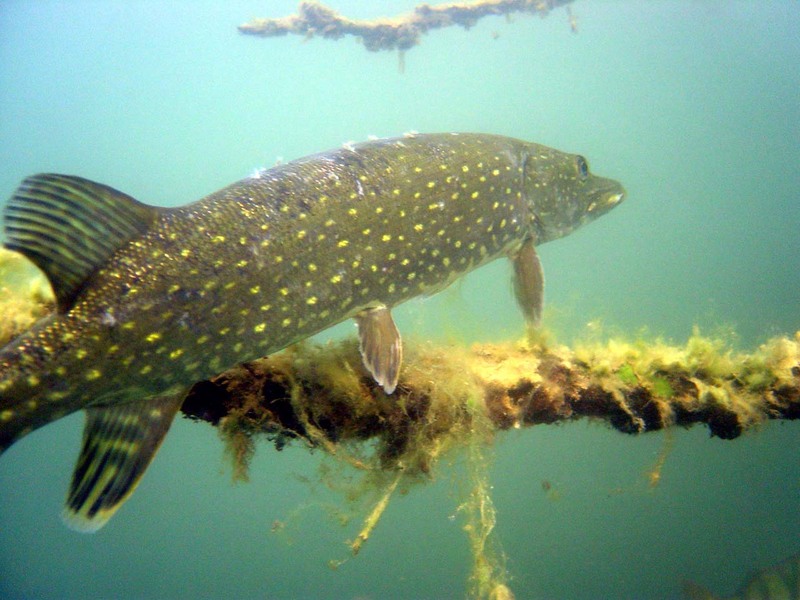Northern pike
From Wikipedia, the free encyclopedia
[Photo] Northern pike in lake Straussee at Strausberg. English: Northern Pike - picture taken with Sony DSC5 in 5 m depth in Straussee near Strausberg. Deutsch: Europ??ischer Hecht - fotografiert mit Sony DSC5 in ca. 5 m Tiefe im Straussee bei Strausberg. Date: 2005-09-08. Author: Gunter K??chler / Berlin (Masturbius)
The northern pike, Esox lucius, is a carnivorous fish of brackish and freshwaters of the northern hemisphere. It is also known by the somewhat misleading folk-name, "water wolf".
Geographic distribution
E. lucius is found throughout the northern hemisphere, including Russia, Europe, the British Isles, and North America.
Within North America, there are northern pike populations in eastern New York, northern New England, most of Canada (though pike are rare in British Columbia), Alaska, the Ohio Valley, the Great Lakes basin and surrounding states, Missouri, and Nebraska. They may be stocked in some western lakes and reservoirs as game fish.
Physical description
Northern pikes are most often olive, shading into yellowish or whitish on belly with short, light barlike spots on body and some dark spots on the fins. The lower half of their gill cover lacks scales and they have large pores on their head and lower jaw. Unlike the similar-looking muskellunge, the northern pike has light markings on a dark body background and less than six pores on the underside of its jaw.
Size
Pike grow to a relatively large size: lengths of 150 cm and weight of 25 kg are not unheard of. The largest specimen so far was caught in an abandoned stone quarry, in Germany, in 1983. It was 147 cm (4.8 feet) long and weighed 30.5 kg (67 lbs). The longest pike was 152 cm (5 feet) long (weight 27.5 kg, 60.6 lbs). There were reports in older days of giant pikes of up to 40,77 (89 lbs) and 41.5 (91.5 lbs) kg, in particular from Ireland, most of which were researched by Fred Buller and published in "The Doomsday Book of Mammoth pike", supposedly caught in nets at the end of the 1800s. The British Islands have not managed to produce much in the way of giant pikes in the last 50 years or so however, wherefore there is much doubt surrounding those claims. Northern Pikes in North America seldom reach the size of their European counterparts, however, one of the largest being a 20.9 kg (46 lbs) specimen from New York state. There are reports of far larger pike, but these are either misidentifications with its much larger relative the muskellunge, or simply have not been properly documented and belong in the realm of legend.
Alternate forms
Northern pike occasionally breed with muskellunge to produce tiger muskellunge (Esox masquinongy immaculatus), a muskellunge subspecies. Another form of northern pike, the silver pike, is not a subspecies but rather a mutation that occurs in scattered populations. Silver pike, sometimes called silver muskellunge, lack the rows of spots and appear silver or silvery-blue in color. (Craig, 1).
Habitat
Pikes are found in sluggish streams and shallow, weedy places in lakes, as well as in cold, clear, rocky waters. The pike generally hides in wait for prey, holding perfectly still for long periods, and is then capable of remarkable acceleration, sometimes propelling it a meter into the air (though it rarely leaves the surface). It catches its prey sideways with its sharp teeth, in order to kill it, before turning lengthwise to swallow. It eats mainly fish, but on occasion water voles and ducklings have also been known to fall prey to pike. It is moreover a cannibal and this cannibalism serves in maintaining stability in the pike population. Young pike have been photographed eating pike of a similar size. Northern Pike also feed on others of their kind, insects, and leeches. It has a tremendous appetite.
Importance to humans
While a worthy adversary for any rod and line fisherman, pike are often caught and released by fishermen since its flesh is bone-filled. However, the larger fish can be filleted, and pike have had a long and distinguished history in cuisine and are popular in Germany, with historical references to its cooking going back as far as the Romans. Pike have very white, mild flesh, and are considered one of the best tasting freshwater fish. When eating pike, be sure to chew carefully, as their "y-bones" are not always easily visible.
Fishing for pike is said to be very exciting with their explosive hits and aerial acrobatics. The pike are some of the biggest freshwater fish.
Etymology
The northern pike gets its name from its North American habitat and its resemblance to the pole-weapon known as the pike (Esox also means "pike"). It's also known as the American pike, common pike, great northern pike, Great Lakes pike, grass pike, pickerel, snake, northern, and jackfish. Numerous other names are found listed by Weed in Field Museum Zool. Leaflet Number 9.
http://en.wikipedia.org/wiki/Northern_pike
| The text in this page is based on the copyrighted Wikipedia article shown in above URL. It is used under the GNU Free Documentation License. You may redistribute it, verbatim or modified, providing that you comply with the terms of the GFDL. |
|

